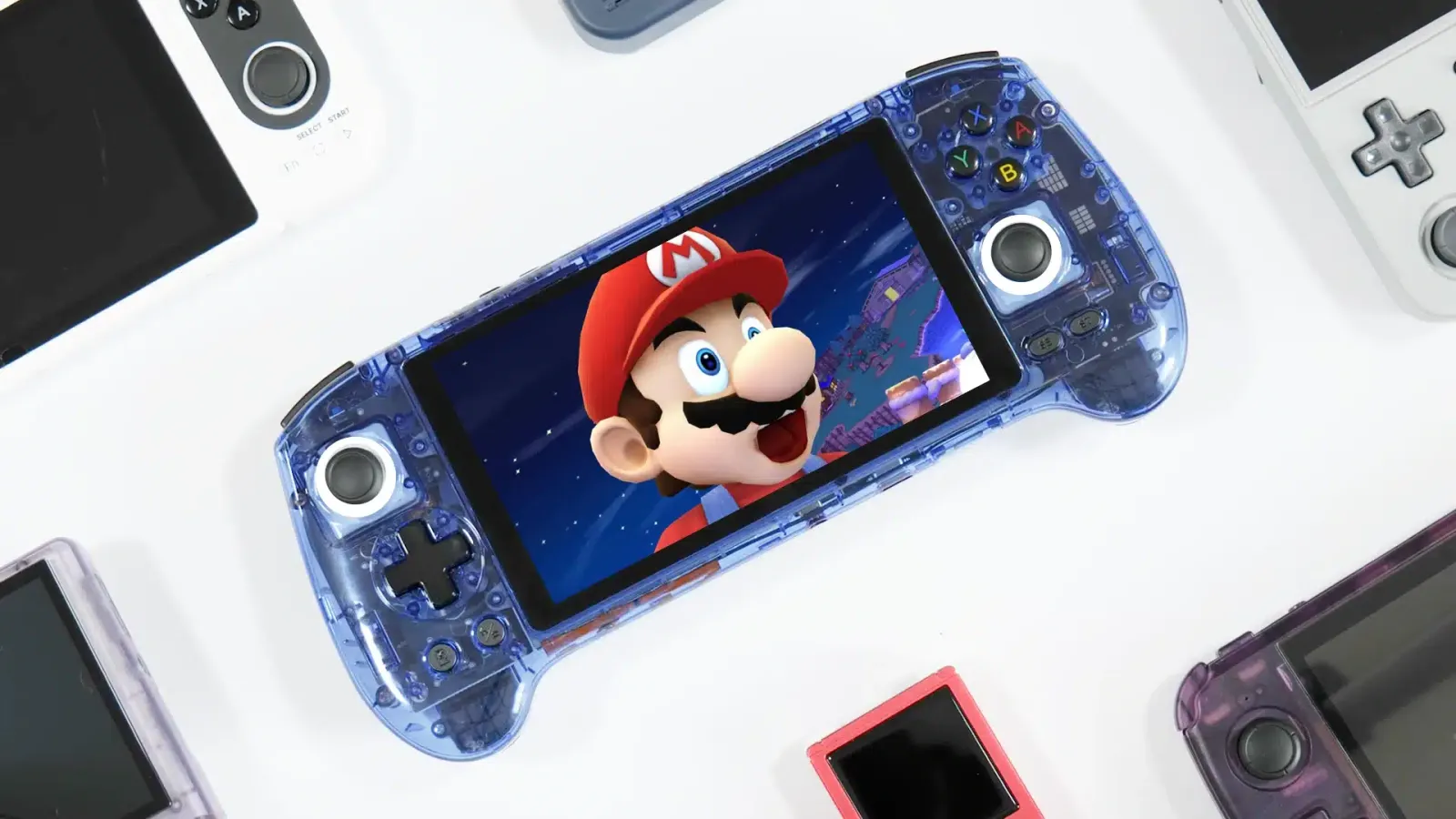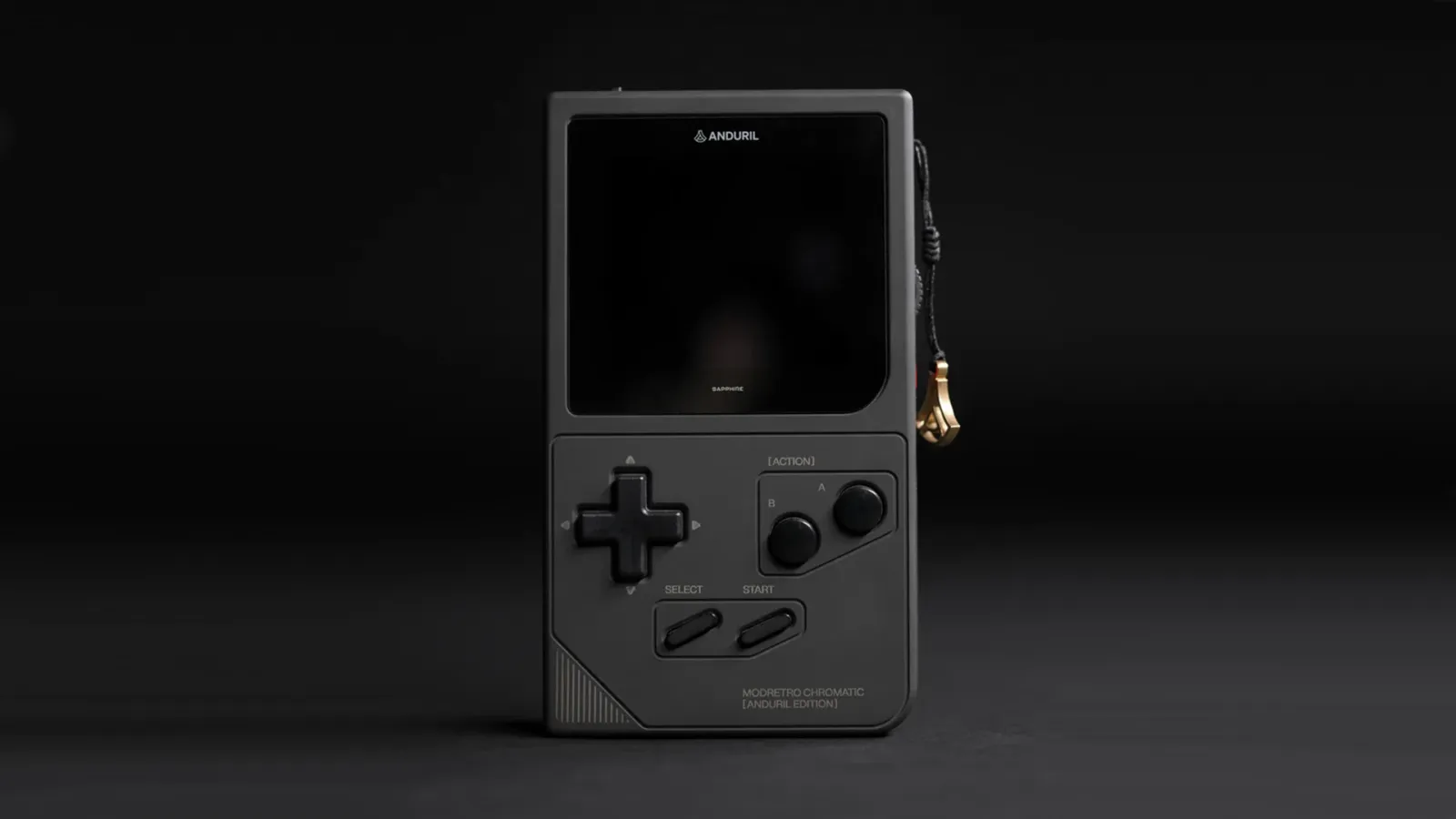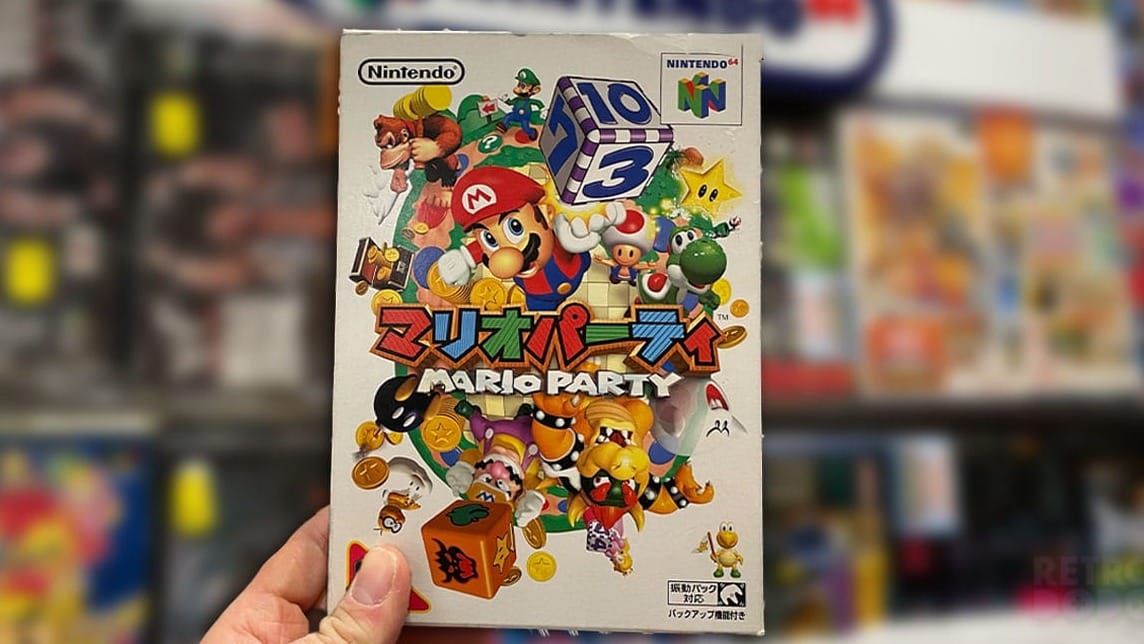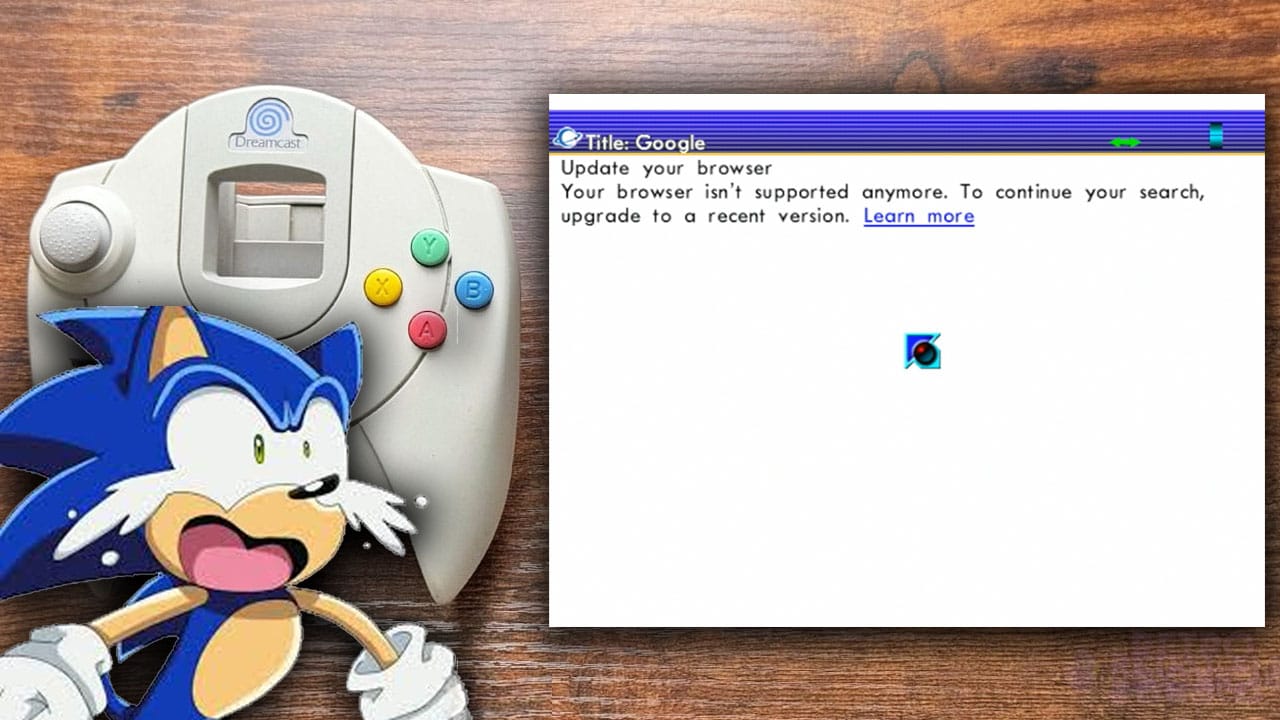The ANBERNIC RG556 is a horizontally orientated Android based handheld that can emulate a wide range of different consoles which retails for $184.99.
For full disclosure, we were provided with a review unit ahead of its public release, so thanks to ANBERNIC for arranging that with us.
The RG556 is positioned as a competitor to the Retroid Pocket 4 line of handhelds, with it sitting in the middle of the base model and the Pro model in terms of cost and power which might make it a pretty attractive alternative to what Retroid are offering.
ANBERNIC RG556 Specifications
- 5.4″ AMOLED Touch Screen (1080p)
- Unisoc T820 CPU
- Mali-G57 GPU
- 8GB RAM
- 128GB of internal storage.
- 5000MAH Battery
- WiFi & Bluetooth
Looking more closely at the specs, we’ve got a Unisoc T820 CPU, Mali-G57 GPU, 8GB of RAM and 128GB of internal storage. It also has built in Wi-Fi and Bluetooth and features a 5500mAh battery, giving you around 8 hours of average use and the display features a 16:9 aspect ratio with a resolution of 1920 x 1080, it’s also an AMOLED screen that’s 5.48 inches in size and of course, it’s also got touch functionality which makes it much easier to navigate menus.
Design & Display
This brings me on to the first thing I want to address from the previous review. I mentioned that although the screen is really good on paper, it has this weird blue tint to it which ends up making the display look a little bit off at times and kinda lets it down.
However, what I didn’t realise is that you can fix this by going into the Settings menu, then Display, Colours & Contrast and setting the screen to Standard mode. This completely fixes the weird blue effect on the screen and makes it look incredible.
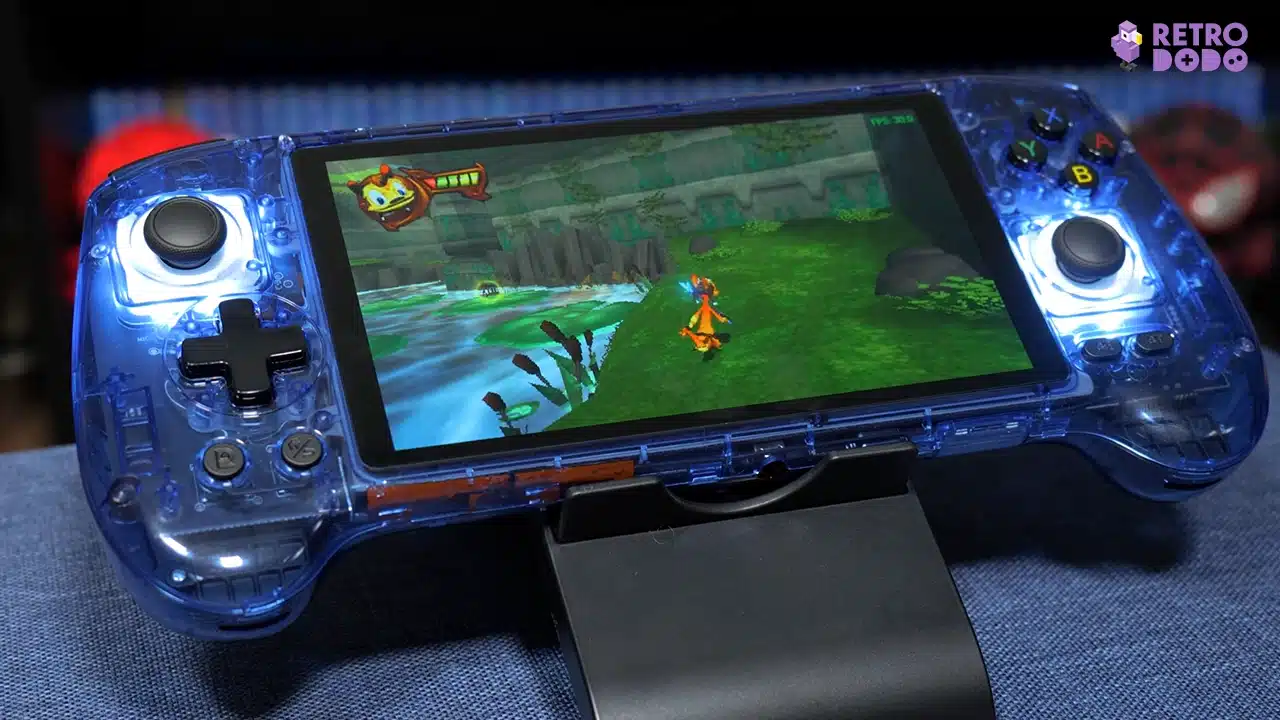
To my credit here, this really should be the default display mode and it’s very strange that you would have to dive into the settings to rectify this, but it is fixable and I should have spotted that during my initial testing, so that’s definitely on me.
The bottom line here is that the screen is great and actually better than what’s being offered by Retroid thanks to it’s bigger resolution and the fact it’s an OLED screen too.
Taking a look at the build of the RG556 now, the stand out feature for me is the grips on the back of the device which give your fingers somewhere to naturally rest and makes the device extremely comfortable to hold. I’ve used this thing quite a lot now and I have absolutely no complaints with how it feels.
The shell is made of this smooth glossy plastic which I was worried would feel a bit slippery, but surprisingly it actually doesn’t slip around at all and the device has a surprising amount of weight to it, coming in at over 330g which makes it feel like you’re getting a premium product that isn’t going to fall apart in your cold clammy hands.
The analogue sticks are very similar in feel and size to a Nintendo Switch Joy-Con but feel sturdy and are even hall-effect sticks, meaning they shouldn’t drift like the Joy-Cons are prone to.
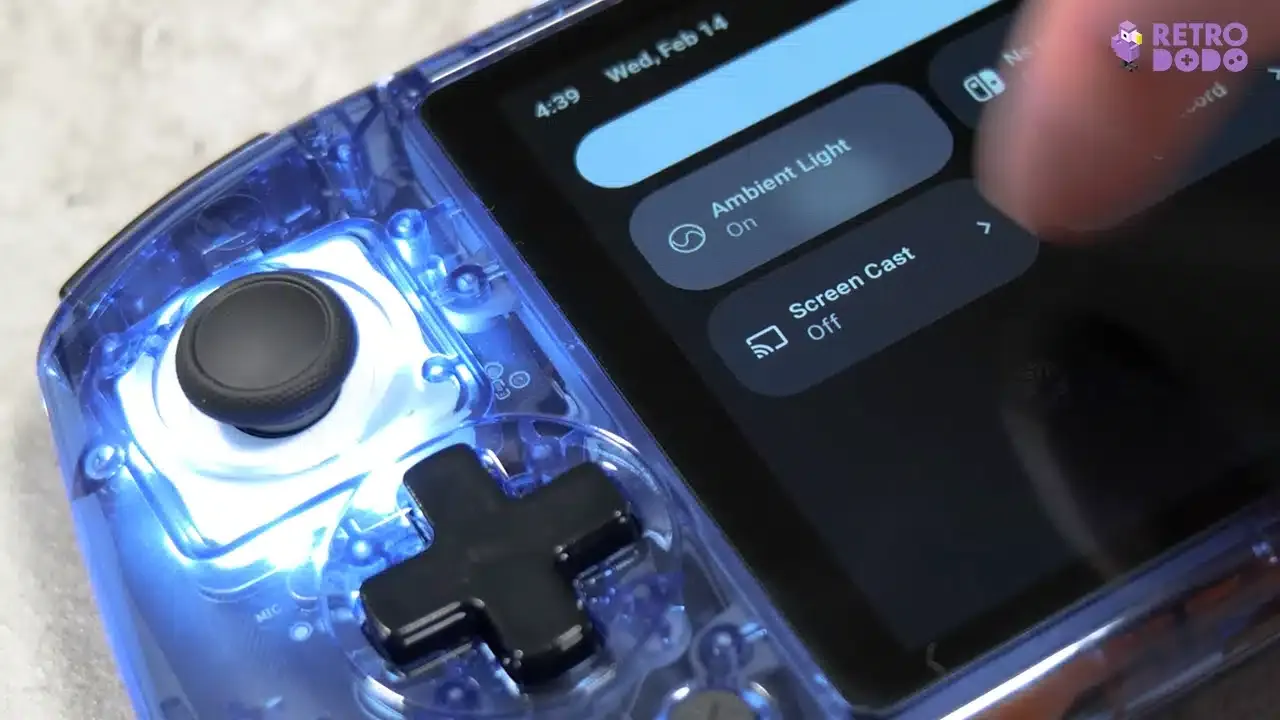
The action buttons offer a good amount of resistance and don’t wobble in the shell and the D-pad is quite good too. It is very slightly loose which could result in false diagonals, but from my testing this wasn’t a common issue at all.
Something which adds a degree of spectacle to the device is the fact the there’s LED lights around the analogue sticks and this is where we hit the second mistake of the previous video where I said that it’s annoying how you can’t dim these.
Well yeah you can. You just have to go to the Android quick settings, scroll across to the Ambient Light option and instead of tapping it like I was doing, you hold it and it opens up the advanced options where you can not only dim the lights, but give it a fancy breathing effect too.
Now this mistake was just down to me clearly being inexperienced with Android despite the fact that I literally have an Android phone that I use every single day. Maybe I’m just an idiot, but I had absolutely no idea that you could hold these quick settings to go to a more advanced menu. So yeah, I definitely learned something here, thanks for pointing that out to me in the comments of the last video.
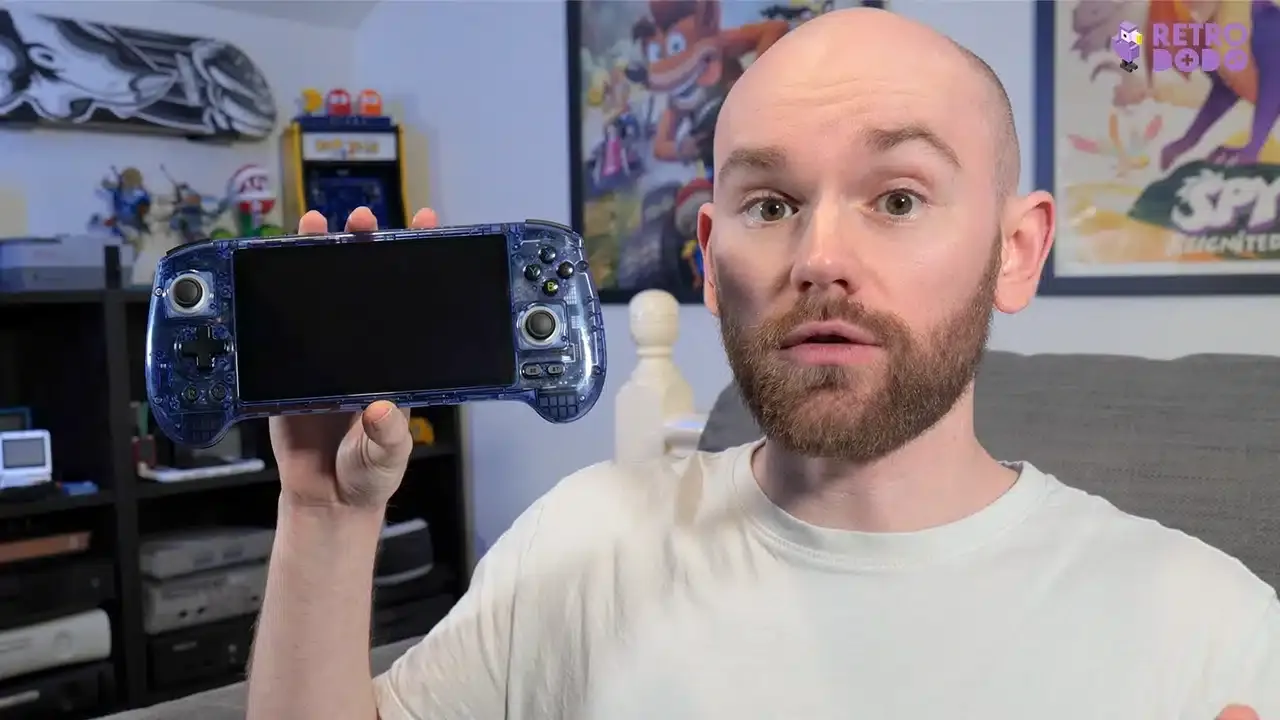
What I will say though, is that it is still a little bit disappointing that you can’t change the colour of these LED lights, that would have made them even better, but regardless, the options you do have are pretty cool.
Other than that though, you’ve got all the standard stuff like the function buttons for menu navigation, start and select, the volume buttons on the top of the device and next to those you’ve got the power button which can be tapped to enter sleep mode.
The shoulder and trigger buttons are really good on here too, the L1 and R1 buttons are big enough that your fingers can rest on them and press them with ease and the triggers have the perfect amount of travel to them, being satisfying to press but not going too far back that it feels like you’re constantly going to slip off.
The R1 and L1 buttons are a bit clicky which could be annoying if you were playing a game which used them a lot. Trust me you don’t want to be in bed with someone playing Ape Escape on this thing.
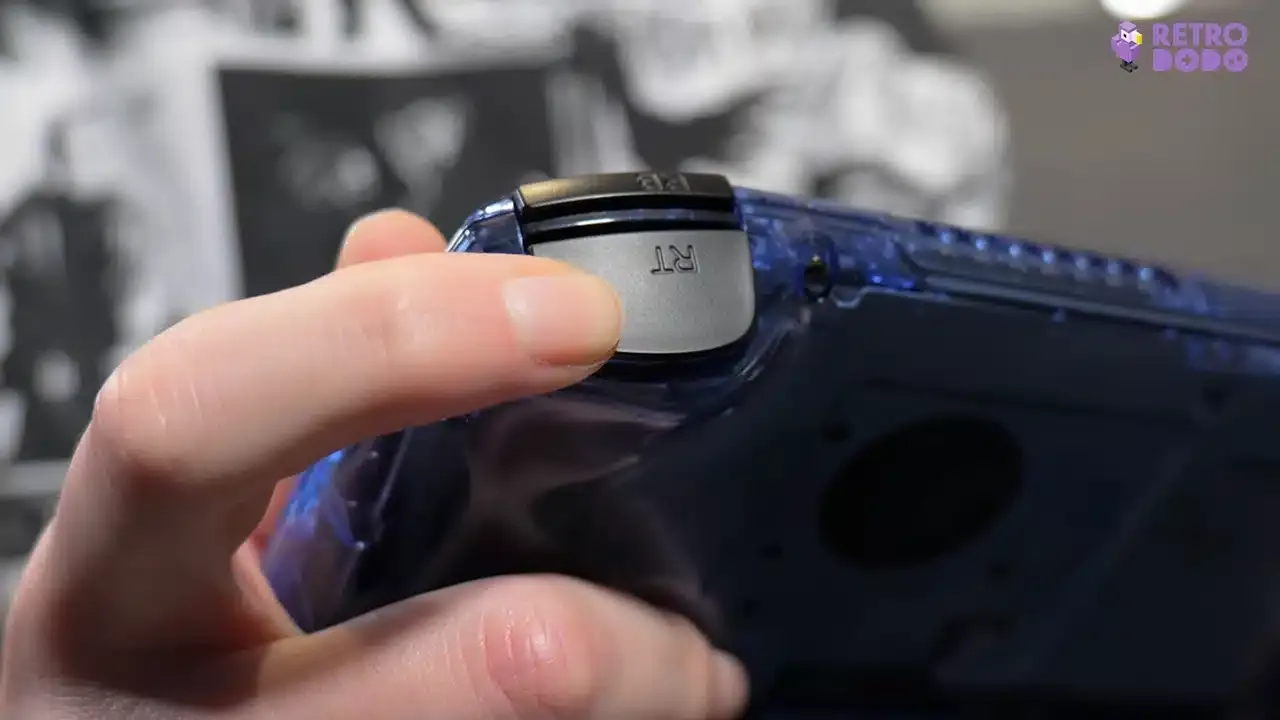
And now we should probably tackle the biggest thing I got wrong in the last review which is where I went off on one about how the L2 and R2 triggers are supposed to be analogue but weren’t on my device and I complained about this for ages.
Yeah… you just need to activate the analogue triggers in the menu by turning the Xbox Mode on. That’s it. That completely fixes the biggest issue I had with the device.
Now am I stupid for not noticing this. Yes. But at the same time, again, why isn’t this the default option when you initially turn the device on? Surely most people are going to want the analogue triggers to be active out of the box?
And also, why is the analogue trigger function tied to swapping between the Nintendo and Xbox button layout? Surely the button layout and the analogue trigger activation should be two separate settings on the menu? You’ve got to admit that’s a bit confusing right?
The main games that utilise the analogue triggers are GameCube games which are made by Nintendo, so I never would have thought that changing from the Nintendo layout to the Xbox layout would have impacted the triggers like this.
So yeah, while this mistake is definitely on me. I do think it’s a little bit understandable as to why I didn’t think to change this particular setting, but I tell you what, I definitely won’t be making that mistake again that’s for sure!
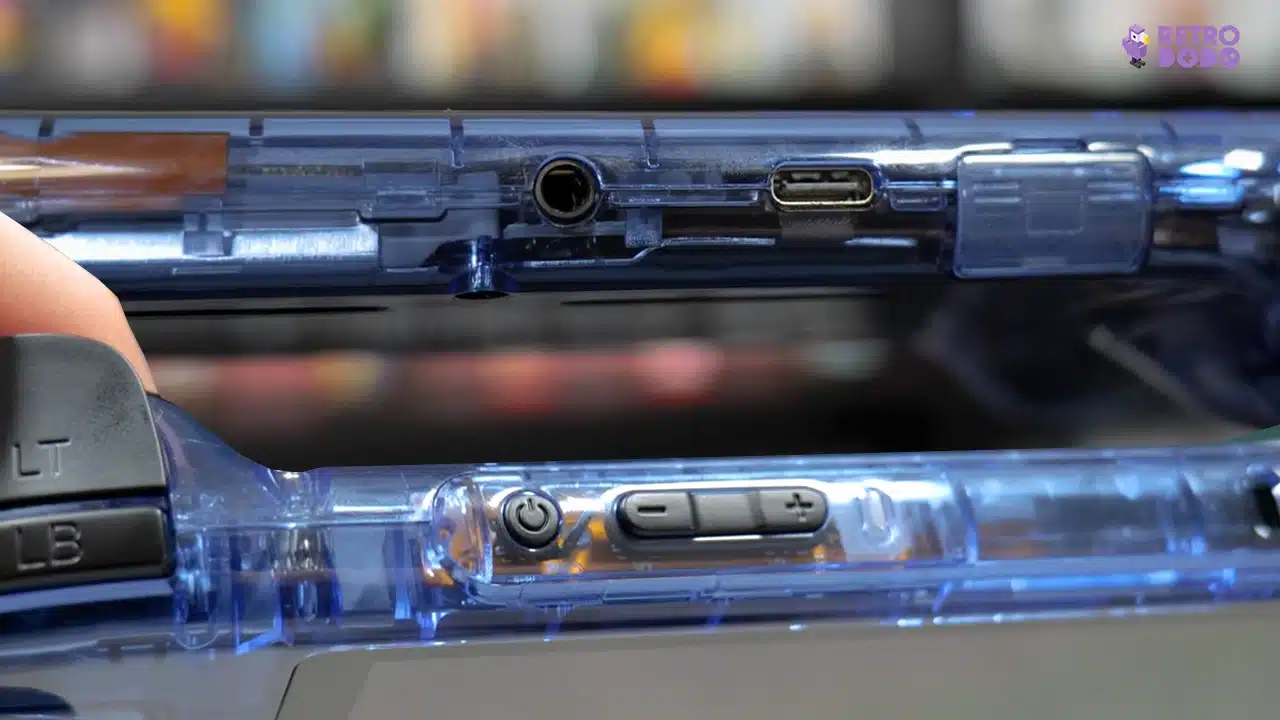
On the bottom of the device you’ve got the headphone jack, a microSD card port to expand the storage on offer and a USB-C port which is used for charging, data transfer and… Yes it does support video output…
Once again, in my last video I said that the video output wasn’t working and even went as far as to explicitly put people off of getting this if they want a device that can output to an external display.
Turns out it was just that my adapter wasn’t compatible with the RG556 and using a recommendation by Russ from Retro Game Corps, I got this Anker USB-C to HDMI adapter and it immediately worked, making me look even more like an absolute buffoon than I already do at this point.
Now, look. Should I have tested another USB to HDMI adapter before straight up saying it doesn’t work.
Yes I should. However, this USB dock which by the way works perfectly for my Steam Deck, does specifically state on the Amazon page that it works with any device. It literally says right here “Universal Compatibility”, so I just took them at their word when I probably shouldn’t have.
But look, the good news is that because the video output on the RG556 does work, it basically means you’ve got a whole portable console you can take around with you.
By connecting Bluetooth controllers to the device you can even play multiplayer games too and this dramatically increases the versatility of the device. So at the end of the day, this is very good news.
RG556 User Experience
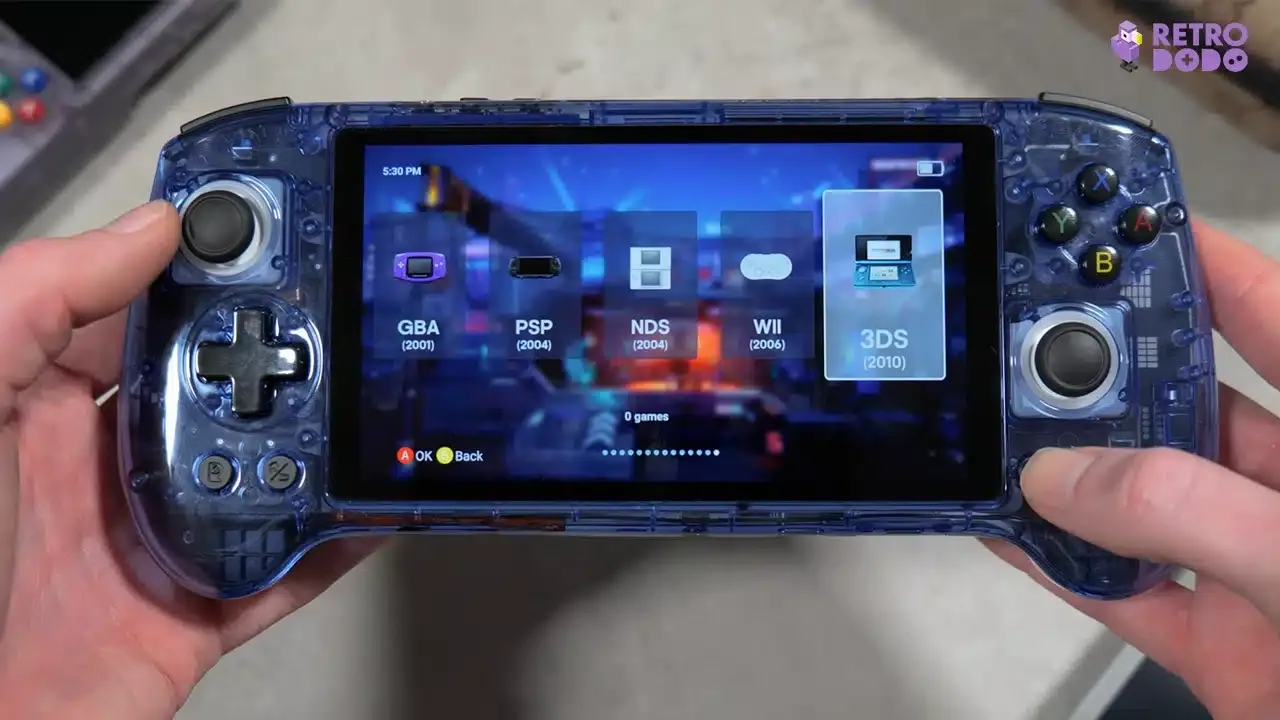
The frontend that this device comes pre-loaded with is called RG Launcher and in my opinion, this is the main thing that lets the device down.
It just doesn’t look all that great even when you go through the customisation options and it’s a massive pain to navigate through the settings.
In the last review I complained that I couldn’t find a way of adding games to the front end that were stored on the internal storage and while I did actually find how to do that, I still maintain that the UI is so clunky and awkward to use that you’re better off just sticking to the Android interface instead.
It would be great if ANBERNIC made their own front end that not only looked sleek but talked you through the initial setting up process, allowing you to install up to date emulator apps, set your ROM directories, configure controller bindings and hotkeys and access resolution upscaling settings all without leaving the front end.
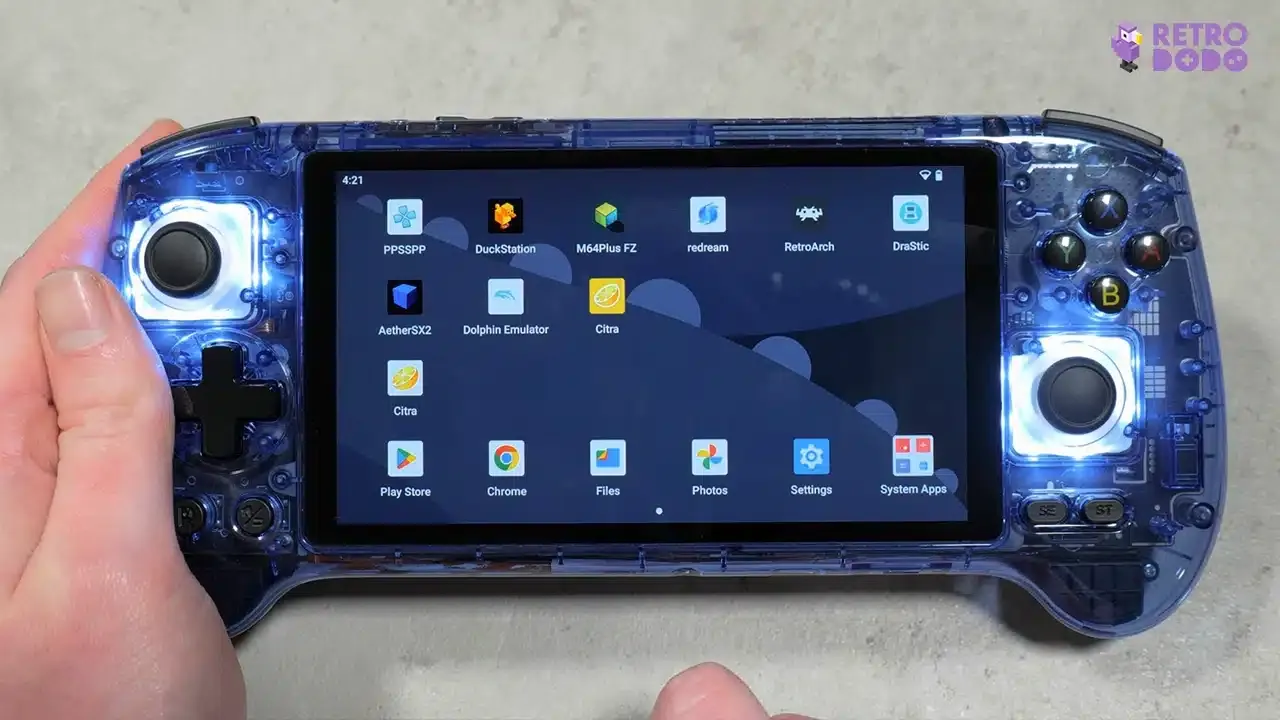
For now though, this doesn’t exist and you’re basically left on your own to download and configure each individual emulator, which can be a pretty time consuming process and sort of saps the initial fun out of getting one of these devices.
To the RG556’s credit, it does come with a lot of emulation software pre-installed, however I found that a lot of these were outdated and could potentially result in sub-par performance because of the amount of updates the software has received since these older versions released.
So I would always recommend that you completely uninstall everything and start again from scratch so that you have full control over your apps and you know that they’re the recent versions.
But after you’ve re-downloaded and configured everything manually, You’ve finally be at the stage where you can get playing and this is probably where the RG556 truly shines.
ANBERNIC RG556 Emulation Performance
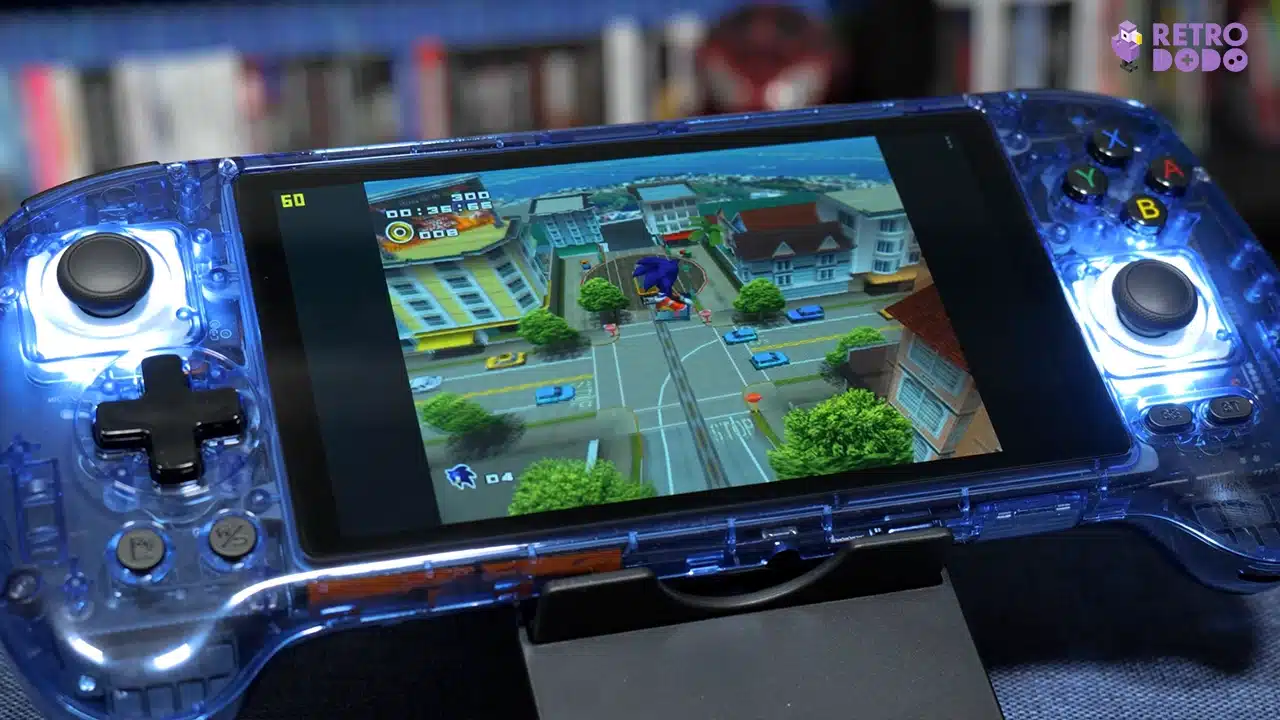
Any classic or early 3D systems are going to play absolutely perfectly on this device. So anything from the Atari 2600, NES, SNES, N64, PS1, Dreamcast or similarly powered consoles are going to run like a dream and even be upscaled without impacting performance.
Crash Team Racing on the PS1 is running through the stand-alone DuckStation emulator here with a 5x upscale to make it 1080p and as you can see, it’s absolutely flawless. Similarly, Super Mario 64 on the N64 is running through the M64Plus FZ emulator at a resolution of 1440 x 1080 and looks stunning while also performing with literally no issues. Dreamcast is running through redream at a resolution of 1920 x 1440 and once again as you’d probably expect by now, it runs perfectly.
Whether you’d realistically want to upscale these games this much is up to you, but personally, I tend to only upscale to the equivalent of 720p on devices like these because the difference between that and higher resolutions on a screen this small is going to be very minor, but hey if you want to take full advantage of that 1080p screen, you can definitely do that.
Pushing into the more demanding consoles, let’s start by looking at Grand Theft Auto III on the PS2 which is running through AetherSX2 at a 2x upscale.
Personally, I found going up to a 3x upscale here made the performance struggle a little bit when things got a bit hectic, so for these systems I’d probably stick to a 2x upscale which to be fair, still looks incredible on such a small display. This is a reasonably easy game to emulate and as to be expected, performance was great.
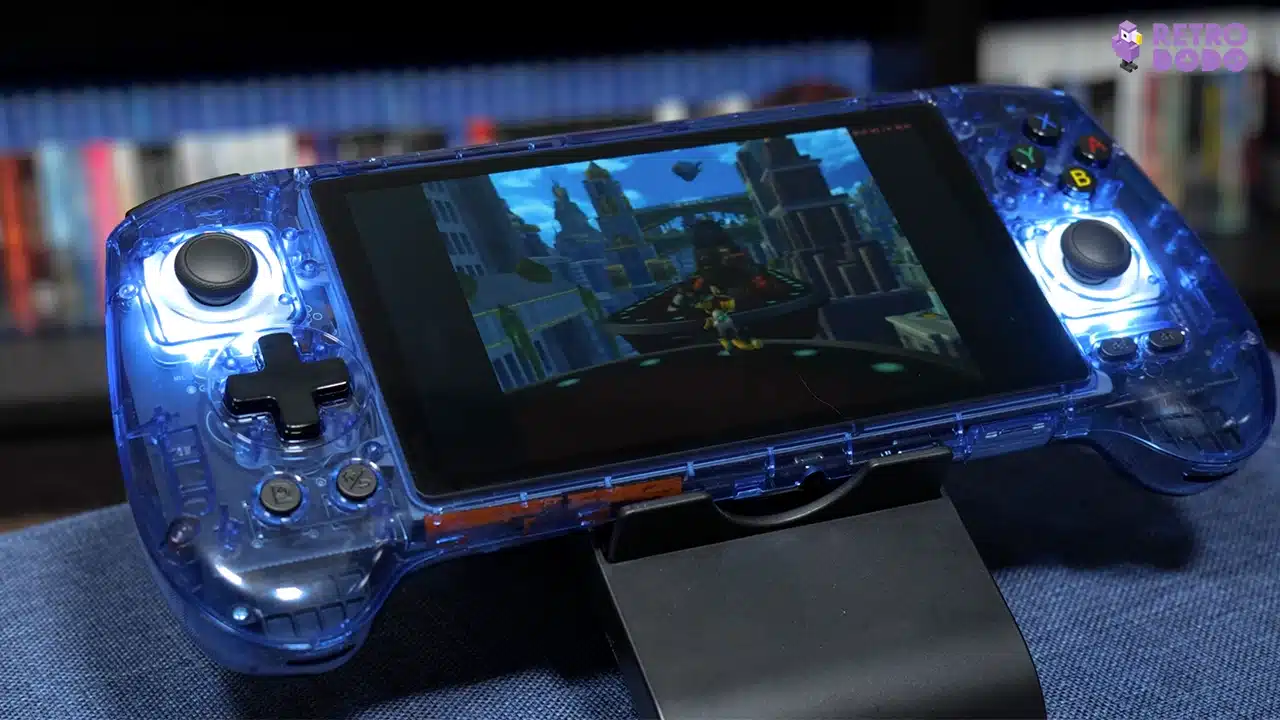
I also tested Tony Hawk’s Pro Skater 3 which was as smooth as butter and was very pleasantly surprised by the performance of Metal Gear Solid 3, one of the more demanding PS2 games which this device ran amazingly well. I expected to get at least minimal frame rate dips here but it was perfect.
The only game I tested which did struggle a tiny bit but not to the point where it was game breaking, was Ratchet & Clank where it did start to chug in certain areas, however, it quickly corrects itself and never got to a point where it was unplayable.
GameCube emulation is a similar story. For this I’m using the Dolphin emulator and found that upscaling to 1080p was a bit too much to handle. So going to 720p which is a 2x upscale seemed to be the sweet spot and most games looked and performed amazingly.
Super Mario Sunshine was a blast and thanks to the analogue triggers, you can move and use F.L.U.U.D. at the same time. Mario Kart: Double Dash!! was also perfect and Super Monkey Ball ran great too.
Admittedly this did struggle with slightly more dynamic stages at first, but once the shaders cached it sort of caught up with itself and performance was great. The only game I tested that didn’t run very well was F-Zero GX. Even with the Dual Core mode enabled and the resolution set to native, it was running at a frame rate of around 40 or below most of the time which results in it being practically unplayable.
This is a very intense game though and I would imagine that the vast majority of the GameCube library would be perfect here.
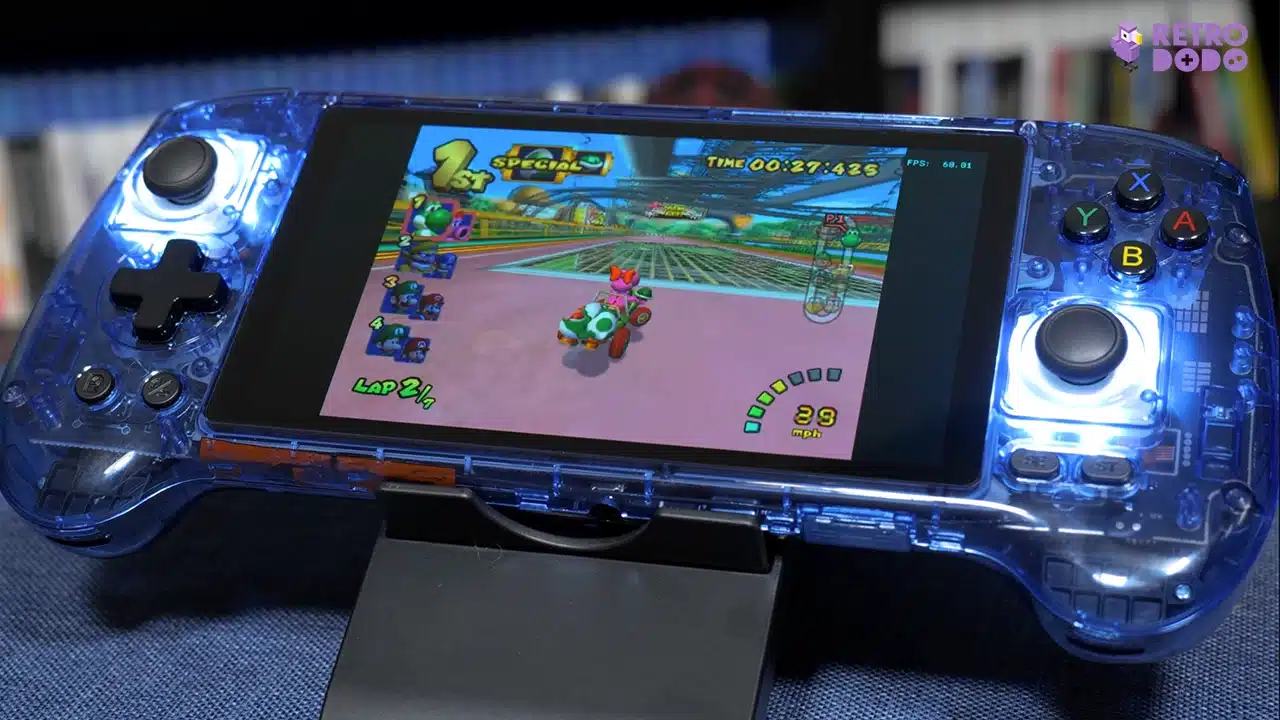
Wii emulation is quite similar to GameCube in the way that it uses the same emulator, but here I found that a 2x upscale was a little bit too much to handle in Mario Kart Wii and I actually had to go down to a native resolution.
By doing that though the performance was amazing and it still looked great too because the native resolution of the Wii isn’t bad by default anyway, especially on a handheld.
The more demanding portable systems like the PSP and 3DS also run impressively well. Going straight into the deep end with God of War: Ghost of Sparta running in the PPSSPP emulator at a 2x resolution, the frame rate was impressively stable and less demanding games like Daxter could even be bumped up to a 3x upscale with no impact on performance.
What’s great about this particular system too is that it fully utilises the widescreen aspect ratio of the RG556 and fills the entire screen, making this an awesome option if you’re looking to play a lot of PSP stuff.
Now maybe I could be doing something wrong here, but 3DS seemed to be a bit more difficult to set up here. Using the standard version of Citra or Citra Enhanced seemed to result in games being absolutely unplayable, the frame rates were so bad that there’s just no way you’d be able to put up with it.
It really wouldn’t surprise me at this point if there was some kind of setting I’m missing that would just fix this, but for now I’ve been using a version of Citra called Citra MMJ which is more aimed at pure performance.
I was getting pretty much perfect frame rates here with the only downside being that certain textures weren’t loading correctly. In certain games this is pretty much unnoticeable but in others it’s fairly distracting, but if you can get over that, 3DS is actually really playable here. Because of the screen being fairly large, horizontally orientated and having touch capabilities, it actually makes it ideal for emulating these dual screen devices too.
I don’t usually test Switch emulation because quite frankly a lot of these handheld devices won’t run many Switch games and I’m personally not too sure where I stand on the morality of Switch emulation considering it’s still heavily supported by Nintendo as their current system. But just to be extra thorough here, as to be expected, Switch emulation is a little bit too much for the RG556 to handle.
Testing out a fairly light weight game like Cuphead resulted in frame rate dips that make the game very difficult to play, although I wouldn’t call this absolutely unplayable at the same time. I feel like any extremely simple games with basic graphics will probably run on this quite well, but as you creep up to 3D or the more complex 2D games, you’re going to start to see it really struggle.
Overall Opinion
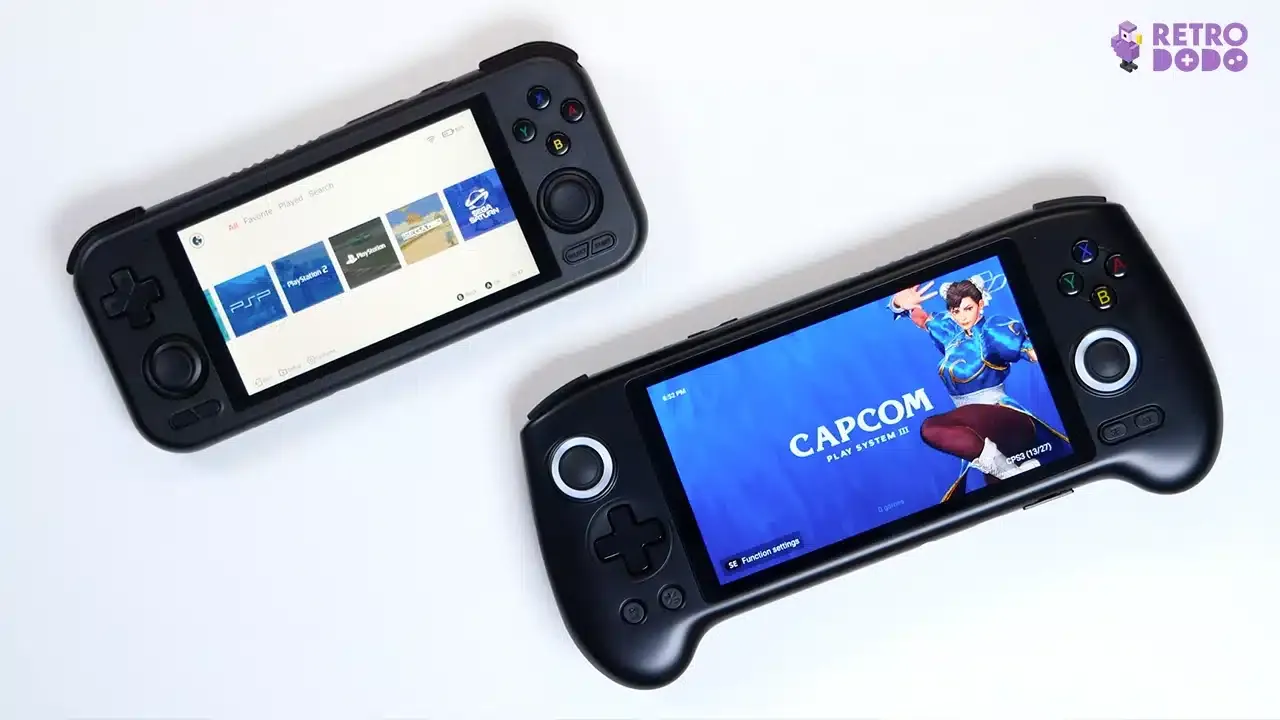
I’m giving this a 8 out of 10.
Now that I’m not being a moron and I’ve sorted out pretty much everything I was complaining about originally, this is actually an amazing device which is almost unbeatable at this price point.
While the Retroid Pocket 4 Pro is slightly more powerful, the RG556 has a better screen and a bigger battery while also having decent specs which will allow it to play practically everything the Pocket 4 Pro can anyway.
There’s actually not much to complain about here, with the only real gripe I have that’s actually valid being that the front end isn’t the best and the setting up process is a bit convoluted which potentially makes this a device which isn’t suited to beginners.
If you know what you’re doing though, or you don’t mind doing a lot of research on the setting up process then I would highly recommend the RG556.
It is also a shame that you can’t change the colours of the LED lights around the analogue sticks and it does struggle a little bit with the really demanding titles from the PS2 and GameCube generation, but outside of those nitpicks, this is a great alternative to the Retroid Pocket 4 Pro and in a lot of ways might actually work out to be the better choice.


